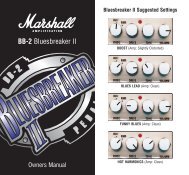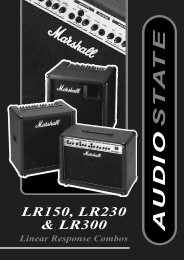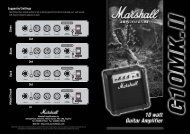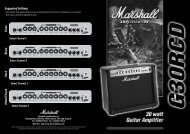BOOK-00105-00 issue5 (NB EDIT).indd - Marshall
BOOK-00105-00 issue5 (NB EDIT).indd - Marshall
BOOK-00105-00 issue5 (NB EDIT).indd - Marshall
You also want an ePaper? Increase the reach of your titles
YUMPU automatically turns print PDFs into web optimized ePapers that Google loves.
OWNER’S MANUAL<br />
JMP-1H and JMP-1C<br />
Limited Edition, 50th Anniversary, all-valve 1-Watt Head and Combo<br />
commemorating the 1970s decade of <strong>Marshall</strong>
From “the Guv’nor” Jim <strong>Marshall</strong><br />
Congratulations on purchasing one of our Limited Edition<br />
series of 1-Watt heads and combos that celebrate <strong>Marshall</strong>’s<br />
50th Anniversary. Each one is made in England with pride<br />
and commemorates the distinctive tonal character, features<br />
and iconic appearance of a specifi c decade – ’60s, ’70s, ’80s,<br />
’90s and present day. This one is the second in the series and<br />
represents the sounds of the <strong>Marshall</strong>s manufactured in the<br />
company’s second decade of existence, the 1970s...<br />
As you may know, the <strong>Marshall</strong> amps most prevalent in the<br />
’70s were the 50-Watt 1987 head and, of course, the 1<strong>00</strong>-Watt<br />
1959 Super Lead head. While the 1959 is often referred to<br />
as a “Plexi” because of the Plexiglass front panel used in the<br />
’60s, we actually changed the material of the front panel to gold<br />
anodised aluminium in the middle of 1969 for added robustness.<br />
This is refl ected in your 1-Watt head or combo, as is the use<br />
of the now familiar JMP legend which stands for Jim <strong>Marshall</strong><br />
Products. In keeping with the company’s credo of listening to<br />
what our customers want, by the time the ’70s arrived, the 1959<br />
Super Lead had evolved into a much more aggressive sounding<br />
amp than its mid ’60s predecessors.<br />
The 1-Watt amp you now own pays homage to both the tone<br />
and look of that pivotal second decade of <strong>Marshall</strong>’s history. It<br />
also does so at an extremely “studio” or “home friendly” volume.<br />
In keeping with the era, the front panel of your amp is simple,<br />
but extremely effective. I’m sure that its touch responsive,<br />
aggressive overdriven tones will give you countless hours of<br />
playing pleasure.<br />
Welcome to the <strong>Marshall</strong> family!<br />
Yours Sincerely,<br />
Jim <strong>Marshall</strong><br />
Overview<br />
The JMP-1H head and JMP-1C 1 x 10" combo<br />
are all-valve 1-watt amplifi ers specifi cally<br />
designed and voiced to produce the sound<br />
of <strong>Marshall</strong> products made in the 1970s. The<br />
<strong>Marshall</strong>s of this decade had a solid, punchy mid,<br />
a tight bottom-end and an aggressive yet musical<br />
overdrive when “cranked”, making the Super<br />
Leads the sonic mainstay of many of the ’70s<br />
most popular and infl uential artists.<br />
The JMP-1H and JMP-1C both utilise two<br />
ECC83 (a.k.a. 12AX7) dual-triode valves to<br />
shape the tone and gain structure in the preamp.<br />
The Class-A, parallel single-ended power-amp<br />
topology employs two ECC81 (a.k.a. 12AT7)<br />
dual-triode valves to wring every last drop of<br />
1<br />
harmonic mojo from the circuit.<br />
The added bonus is that you get<br />
that distinctive Super Lead tone but<br />
at the neighbour-friendly volume of 1-Watt. The<br />
additional attenuation offered by the Low Power<br />
button on your amp's rear-panel drops the power<br />
signifi cantly more, should you need to do so.<br />
Follow all instructions and heed all warnings<br />
KEEP THESE INSTRUCTIONS<br />
The combo is loaded with a Celestion G10N<br />
10" 16Ω speaker which delivers the desired tonal<br />
nuances effortlessly. Both head and combo have<br />
options to drive external cabs with a choice of<br />
16Ω or 8Ω. The combo’s internal speaker is<br />
automatically disconnected when an external cab<br />
is plugged into either output.<br />
Warning:<br />
Before going any further, make sure that your amplifi er is compatible with your electrical supply. If you have any doubt, please seek help from<br />
a qualifi ed technician – your <strong>Marshall</strong> dealer can help you in this respect.<br />
Mains Input & Fuse:<br />
Your amplifi er is provided with either a detachable mains (power) lead which should be connected to the mains input socket on the rear panel<br />
of the amplifi er or a fi xed mains (power) lead attached to the rear of the amplifi er.<br />
The specifi c mains input voltage rating that your amplifi er has been manufactured for is indicated on the rear panel of the amplifi er.<br />
The correct value and type of mains fuse for valve amplifi ers is specifi ed on the rear panel of the amplifi er.<br />
NEVER attempt to bypass the fuse or fi t one of the incorrect value or type.<br />
Transporting your equipment:<br />
Please ensure that your amplifi er is switched off and unplugged from the mains electricity supply and that all removable cables have been<br />
disconnected from your equipment before attempting to move it.<br />
Important set up information:<br />
1. Make sure that the cabinet(s)/speakers, where appropriate, are connected to the correct impedance LOUDSPEAKER jack(s) on the<br />
rear panel of the amplifi er. See the Speaker Output guides in this handbook, if applicable, for specifi c information regarding impedance<br />
matching. When using an extension cabinet make sure that you are using a proper speaker cable. Never use a screened (shielded) guitar<br />
cable for this purpose.<br />
WARNING! Failure to do any of the above may damage your amplifi er.<br />
2. Ensure that the VOLUME controls on the front panel are set to zero.<br />
3. For amplifi ers provided with a detachable mains (power) lead, connect the supplied mains (power) lead into the MAINS INPUT on the rear<br />
panel fi rst and then into an electrical outlet.<br />
4. Plug your guitar into the INPUT jack socket on the front panel.<br />
5. Turn the front panel switch ON and, if a valve amplifi er, wait a couple of minutes before going to point 6.<br />
6. Turn the volumes up to your preferred level and your amp is ready to play.<br />
EUROPE ONLY – Note: This equipment has been tested and found to comply with the requirements of the EMC Directive<br />
(Environments E1, E2, and E3 EN 55103-1/2) and the Low Voltage Directive in the E.U.<br />
EUROPE ONLY – Note: The Peak Inrush current for the JMP-1H and the JMP-1C is 4.4A.<br />
ENGLISH
Front panel<br />
1 2 3 4 5 6<br />
NOTE: The JMP-1C front panel is illustrated. The<br />
JMP-1H panel is identical but runs in the opposite<br />
direction.<br />
1. Input Jack Socket<br />
This is where you plug your guitar into the amp.<br />
You must use a screened (shielded) guitar cable.<br />
Never use an unscreened (unshielded) speaker<br />
cable. The input to any guitar amplifi er is a very<br />
sensitive part of the signal path and is therefore<br />
susceptible to electrical interference, hence the<br />
need for a screened guitar cable. This screened<br />
cable should preferably be of good quality.<br />
If you are in any doubt regarding this, your<br />
<strong>Marshall</strong> dealer will be more than happy to help<br />
and advise you.<br />
2. Volume<br />
This control sets the overall output volume of<br />
the amplifi er. Turning this control up will also<br />
increase gain, adding distortion to the sound as<br />
the various stages within are gradually overdriven<br />
more and more. All valve guitar amplifi ers exhibit<br />
this desirable behaviour to varying degrees.<br />
3. Treble<br />
This control determines the amount of high<br />
frequencies (top-end or treble) that are present<br />
and gives your guitar tone more high-end<br />
defi nition and “cut” as it is turned up.<br />
4. Bass<br />
This controls the amount of low frequencies<br />
(bottom-end) in your tone.<br />
NOTE: both the Treble and Bass controls are<br />
passive - meaning that they only attenuate<br />
(reduce) frequencies, they don't boost.<br />
5. Mains Indicator<br />
This red indicator will light up whenever the amp<br />
is plugged into the mains and the Power Switch<br />
is on.<br />
NOTE: Please allow a minute or so for the amp<br />
to ‘warm up’ after switching on. This is perfectly<br />
normal with valves as they need to come up to<br />
their ‘working temperature’.<br />
6. Power Switch<br />
This is the On/Off switch for the mains electric<br />
power to the amplifi er.<br />
NOTE: Please ensure the amplifi er is switched off<br />
and unplugged from the mains electricity supply<br />
whenever it is moved!<br />
Rear panel<br />
1 2 3 4 5<br />
1. Mains Input Socket with mains fuse<br />
Your amp is provided with a detachable mains<br />
(power) lead, which is connected here. The<br />
specifi c mains input voltage rating that your<br />
amplifi er has been built for is indicated on the<br />
back panel. Before connecting for the fi rst time,<br />
please ensure that your amplifi er is compatible<br />
with your electricity supply. If you have any doubt,<br />
please get advice from a qualifi ed technician.<br />
Your <strong>Marshall</strong> dealer will help you in this respect.<br />
The correct value of mains fuse located in the<br />
small compartment at the bottom of the mains<br />
socket is specifi ed on the rear panel of the<br />
amplifi er. The compartment also contains a space<br />
for a spare fuse.<br />
NEVER attempt to bypass the fuse or fi t one of<br />
an incorrect value!<br />
NOTE: It is wise to carry spare fuses at all times.<br />
2. Low Power Mode Switch<br />
When the Low Power switch is engaged (i.e.<br />
pushed in) it reduces the amp's maximum output<br />
from 1-Watt to 0.02-Watts. This is more suitable<br />
for environments where the volume needs to be<br />
kept to a minimum.<br />
JMP-1H and JMP-1C Technical Specifi cations<br />
2 3<br />
3. 16Ω Extension Speaker Output Jack<br />
This is the output used to feed a 16Ω extension<br />
cabinet, a typical example being a <strong>Marshall</strong><br />
4 x 12". When connecting an extension cabinet<br />
to the combo, its internal 16Ω speaker is<br />
automatically disconnected.<br />
4. 8Ω Extension Speaker Output Jack<br />
This is the output used to feed an 8Ω extension<br />
cabinet, a typical example being a <strong>Marshall</strong><br />
2 x 12". When connecting an extension cabinet<br />
to the combo, its internal 16Ω speaker is<br />
automatically disconnected.<br />
NOTE: Plugging an extension cabinet into the<br />
8Ω extension speaker output will automatically<br />
disconnect the 16Ω extension speaker output.<br />
This ensures the amplifi er only ever drives one<br />
load, i.e. 16Ω OR 8Ω.<br />
ALWAYS ensure you use good quality speaker<br />
(unshielded) cables. NEVER use guitar (shielded)<br />
cables.<br />
5. Gain Boost Switch<br />
Pushing this switch in adds another valve stage<br />
to the signal path resulting in a sound that<br />
contains more gain. This is more suitable for<br />
heavy rock/metal styles and also soloing.<br />
JMP-1H JMP-1C<br />
Power (RMS) 1W 1W<br />
Valves 2 x ECC83 + 2 x ECC81 2 x ECC83 + 2 x ECC81<br />
Dimensions (mm) H x W x D 180 x 380 x 195 360 x 380 x 220<br />
Weight (kgs) 5.2 9.4<br />
ENGLISH
Notes Notes<br />
20 21
Denbigh Road, Bletchley, Milton Keynes MK1 1DQ England<br />
Tel : +44 (0)1908 375411 Fax : +44 (0)1908 376118<br />
www.marshallamps.com<br />
Whilst the information contained herein is correct at the time of publication, due to our policy of constant improvement<br />
and development, <strong>Marshall</strong> Amplification plc reserve the right to alter specifications without prior notice.<br />
<strong>BOOK</strong>-<strong><strong>00</strong>105</strong>-<strong>00</strong> / 11 / 11




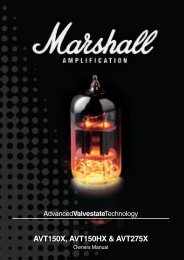

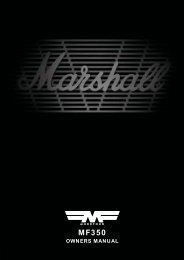
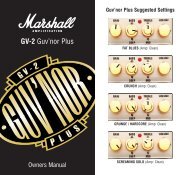

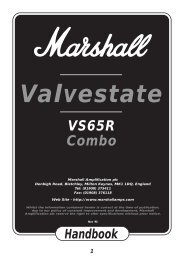
![AVT100X [2.16 MB] - Marshall](https://img.yumpu.com/11365367/1/184x260/avt100x-216-mb-marshall.jpg?quality=85)
